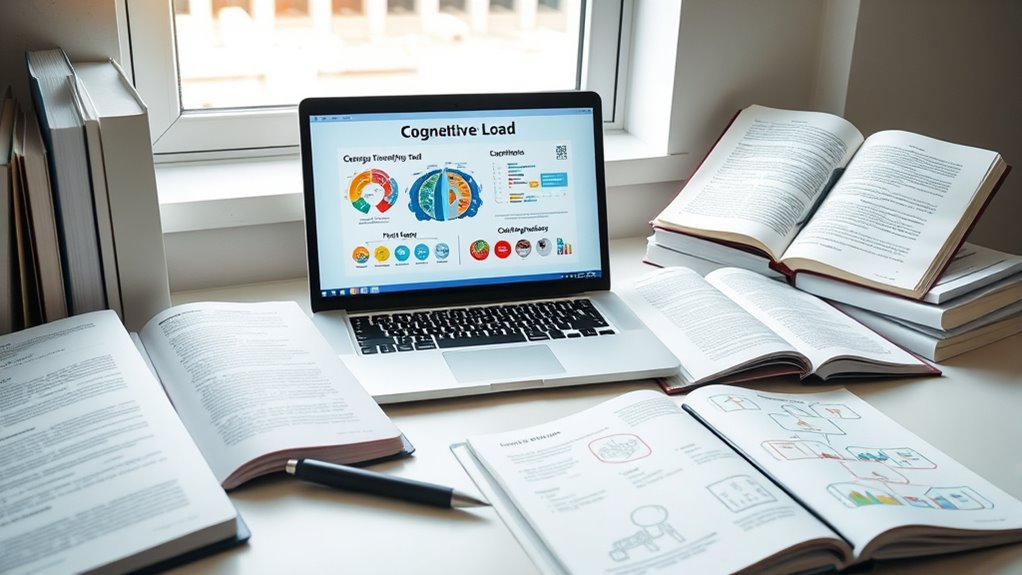To design easier learning materials based on Cognitive Load Theory, focus on simplifying visuals and breaking content into smaller chunks. Remove unnecessary distractions to lessen extraneous load, and scaffold complex topics with step-by-step guidance. Use multimedia to engage multiple processing channels and foster active participation. Tailoring your approach for diverse learners guarantees everyone can understand effectively. Keep these principles in mind, and you’ll discover how to create more efficient, learner-friendly content as you explore further.
Key Takeaways
- Simplify visuals and instructions to minimize extraneous cognitive load.
- Break complex content into smaller, manageable chunks for easier understanding.
- Use multimedia elements like images and videos to engage multiple processing channels.
- Incorporate active learning techniques such as questions and exercises to reinforce understanding.
- Tailor materials to diverse learners’ cognitive abilities, using scaffolding and clear guidance.

Cognitive Load Theory explains how our brain processes information during learning. When you’re designing educational materials, understanding this theory can considerably improve how well your audience retains information. The core idea is that our working memory has limited capacity, so if you overload it, learning becomes inefficient or even impossible. To enhance memory retention, instructional design must account for this limitation, ensuring that learners can focus on understanding without unnecessary distractions or confusion.
Effective instructional design minimizes extraneous cognitive load—those elements that don’t directly support learning—so your learners can concentrate on essential concepts. For example, cluttered slides or overly complex explanations can overwhelm working memory, making it harder to remember key points later. By simplifying visuals, breaking content into manageable chunks, and providing clear, concise instructions, you help your learners process information more efficiently. This approach directly impacts memory retention, as learners are more likely to remember material they’ve been able to understand without feeling overwhelmed. Additionally, recognizing working memory limitations enables designers to create more efficient learning experiences tailored to cognitive capacity.
Minimize distractions and simplify content to boost learners’ memory retention and understanding.
Another vital aspect is managing intrinsic load, which relates to the complexity of the material itself. If you’re teaching highly complex topics, breaking them down into smaller, more digestible parts can prevent cognitive overload. Using scaffolding techniques, like step-by-step instructions or guided practice, allows learners to build understanding gradually, reinforcing knowledge without taxing their working memory. When learners can process each segment thoroughly, they’re more likely to retain the information long-term. Furthermore, considering the limitations of working memory helps instructional designers create more effective learning experiences by aligning content complexity with cognitive capacity. Recognizing that some learners may have different cognitive abilities also fosters more inclusive educational environments, ensuring that materials are accessible and effective for diverse audiences.
Additionally, integrating multimedia elements, such as images or videos, can reduce cognitive overload by providing multiple ways to process information and reinforce understanding. When instructional design encourages active engagement—through questions, discussions, or practical exercises—you promote this productive effort. This not only helps with immediate comprehension but also strengthens memory retention over time. By intentionally designing activities that foster deeper understanding, you enable learners to integrate new knowledge into their existing mental frameworks more effectively.
Frequently Asked Questions
How Can Cognitive Load Theory Improve Online Course Design?
To improve online course design, focus on reducing learners’ cognitive load by using multimedia integration effectively. Incorporate visuals, audio, and text to cater to different learning styles while avoiding overload. Use scaffolding techniques to break content into manageable steps, guiding learners progressively. This approach makes complex topics easier to grasp, keeps learners engaged, and enhances retention, ultimately leading to a more effective and enjoyable online learning experience.
What Are Common Mistakes When Applying Cognitive Load Principles?
When applying cognitive load principles, you often make mistakes like overlooking intrinsic overload, which happens when content is too complex for learners’ current knowledge. You might also create extraneous design that distracts or confuses learners, such as unnecessary visuals or poorly structured materials. To avoid these errors, simplify content when possible and focus on clear, purposeful design that supports learning without overloading the learner’s working memory.
How Does Cognitive Load Theory Differ From Other Learning Theories?
When you compare cognitive load theory to other learning theories, you’ll notice it focuses on managing mental effort during information processing. Unlike theories that emphasize motivation or social interaction, this approach aims to optimize how your brain handles new info by reducing unnecessary load. You actively shape learning materials to match your cognitive capacity, ensuring effective learning without overwhelming your mental resources.
Can Cognitive Load Theory Be Used for Adult Learning?
Thinking about adult learners is like tending a garden—you need the right tools to help them flourish. Yes, cognitive load theory applies to adult learning, making it easier to design materials that prevent overload. Whether for lifelong education or skill development, simplifying content and reducing mental effort helps adults grasp concepts faster and retain information longer. You can enhance their learning experience by applying these principles effectively.
What Tools Assist in Measuring Cognitive Load During Learning?
You can measure cognitive load during learning using eye tracking tools and subjective rating scales. Eye tracking tools help you monitor where learners focus, revealing how much mental effort they’re using. Subjective rating scales allow learners to rate their perceived difficulty, giving you insight into their cognitive load. Combining these tools provides a holistic view, helping you design more effective learning experiences that match learners’ capacity.
Conclusion
By understanding cognitive load, you gently pave the way for smoother learning experiences. When you design materials thoughtfully, you help your learners avoid unnecessary burdens, allowing their minds to flourish quietly. Remember, sometimes the simplest approach whispers the loudest, guiding learners effortlessly forward. When you ease their journey, you’re not just teaching; you’re nurturing curiosity and confidence, creating a space where growth happens naturally and effortlessly.










